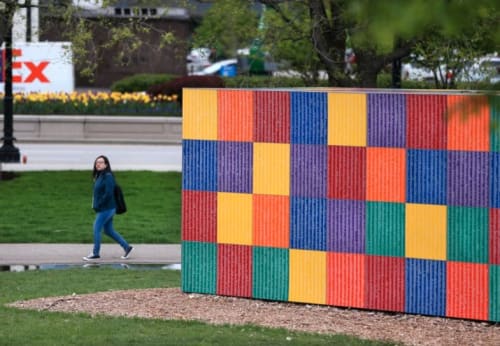The market is up. The market is down. Does it ever go sideways?
I wondered this while standing amid the dizzying pointers of Tony Tasset’s “Me And My Arrow,” a solo show at Kavi Gupta’s Elizabeth Street gallery with two shiny sculptures and 66 insanely colorful paintings, each depicting a pair of arrows, one up, one down.
Yes, it does sometimes go sideways, I thought a few hours later, circling Tasset’s “Artists Monument” at the southern end of Grant Park. There, etched into multicolored panels affixed to two shipping containers, is an alphabetical list of artists’ names collected from online rankings. Just about anyone who has ever been in an art show gets a mention, including Tasset himself. And me, and my husband, and his classmates from graduate school, and Andy Warhol, and 392,479 others.
Tasset, who was born in Cincinnati in 1960 and has lived in Chicago since the early ‘80s, is the Midwest art world’s chief satirist, a conceptual artist who lives to level hierarchies as much as he loves to enjoy their luster.
He’s been recasting high art and pop culture into uncanny packages since at least 1986, when he started making sculptures that resembled minimalist artworks as much as they did modernist couch cushions. A few summers ago, he set a replica of his eyeball, 30 feet in diameter, staring out from a plot of grass in the Loop. He’s installed a giant polystyrene and resin snowman in Miami, where it never melts, and once fashioned a cross that looked like it was made out of five Diet Coke cans. (It was actually cast aluminum with a meticulous paint job. Tasset never skimps on finish. He can’t. Neither could “The Colbert Report.” If the audience doesn’t believe it for at least the first few minutes, it won’t work.)
Tasset is as egalitarian in derision as he is in celebration. Or maybe it’s all the same. It can be hard to know. Exploding hierarchies tends to destabilize the ground on which they are built.
“Me And My Arrow” takes aim at the stock market, the art market, fashion magazine hot lists, the thumbs up and thumbs down of social media postings. The world is brimming with simple judgments that aggregate data and affect finance, behavior and feelings, rarely with a second thought. Normally this trending is all so abstract, so flat, so digital, it can be hard to get a grip on. Here it gains concrete, Technicolor, winsome form.
If the smaller one of Tasset’s painted aluminum arrow sculptures weren’t so cute, coming just up to my knee and dressed with all the levity of a Crayola 64-count crayon set, I’d want to kick it. Instead it’s a toddler, waiting to be cuddled. The larger sculpture, a biggish adolescent, begs to have an arm put around its pointy shoulders.
Tasset’s paintings of arrows are equally surprising and weirdly appealing. With two 31/2-foot arrows per painting times 66 paintings, they equal a staggering 132 arrows total, half up, half down. Graphically perverse and full of multipoint perspective, it’s nearly impossible to tell if there are more than two base patterns. Coloristically diverse, the spectrum and combination of their palette would shame a paint store. Brush marks are visible and regular, surfaces slick but handmade. Hung on four walls in tight, encircling, mural-size grids, they appear bafflingly random, with no discernible order.
This is not what arrows are supposed to do.
For all that up and all that down, everything goes overwhelmingly nowhere. Tasset’s arrows cancel each other out. So much for hierarchies of wealth and taste and popularity.
Something similar happens in Grant Park, faced with the endless list of artists that is the Artists Monument. The sculpture, which debuted at the 2014 Whitney Biennial, isn’t a monument in the traditional sense, dedicated to a significant individual or event. It’s a giant directory that mixes the dead with the living and the unknown with the famous, kind of like the phonebook used to be. Also like the phone book, it’s already out of date. And there’s lots of Adamses, not just Ansel, and loads of Yoshidas. That isn’t how museums and art history sort artists, because it isn’t about being important. It’s about being an artist, any artist, for any amount of time. If you were Paul Gauguin, I suppose it might be humbling (or maybe infuriating) to have Paul Gaugin given equal billing. Myself, I want to know who Nava Massas Waxman was or is. Mystery and narrative color the monument curious and classless.
The Artists Monument will stay in Grant Park until the end of September. Though the cargo containers that form its structure seem willing to go just about anywhere, as the globalized contemporary art world demands, plans are afoot to site it permanently on the University of Illinois at Chicago campus, where Tasset has been teaching art since 1989.
As for the arrow paintings at Kavi Gupta, although they’re slated for dispersal, the panels sold individually, they beg to be bought whole and installed in a corporate lobby. Given the art world’s hunger for critique, even for self-critique, it doesn’t seem too hard to imagine a wealthy collector-cum-CEO buying a dozen arrow paintings for company headquarters.
If that seems a bit cynical, it’s worth recalling that Tasset once sold a 94-foot-tall steel and aluminum rainbow to Sony Entertainment, which arced it over its campus in Culver City, Calif.
Everyone knows the rainbow ends in Hollywood, but only Tony Tasset had the gumption to put a sculpture of it there.
“Tony Tasset: Me And My Arrow” runs through May 14 at Kavi Gupta, 219 N. Elizabeth St., 312-432-0708, kavigupta.com; “Artists Monument” is installed through Sept. 26 in Grant Park at Michigan Avenue near 9th Street.

